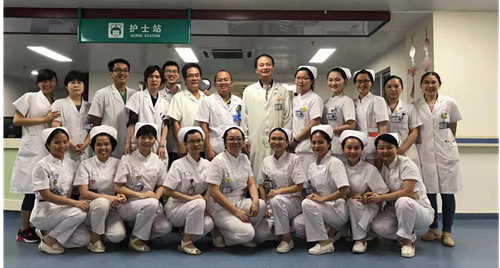

Service
The second ward of Neurology has profound theoretical basis and rich clinical experience in neurocritical medicine, cerebrovascular disease, cerebrovascular intervention, epilepsy, sleep disorders, central nervous system infection, Parkinson's disease, neuroimmune diseases, muscle diseases, hereditary and degenerative diseases, and difficult diseases. Especially in the field of severe neurological diseases, clinical diagnosis and nursing technology is in line with international and domestic advanced technology. It can skillfully carry some advanced techniques such as plasma exchange, neuromuscular biopsy, gene detection of neurological diseases, mild hypothermia treatment, endotracheal intubation and alveolar lavage guided by fiberoptic bronchoscope at bedside, percutaneous tracheotomy, non-invasive and invasive ventilator-assisted breathing, defibrillation and electrocardioversion, central venous perforation, deep vein puncture and catheterization, lumbar cistern puncture and drainage, intrathecal drug therapy, central venous pressure monitoring, subglottic suction, brain death and brain injury assessment, enteral parenteral nutrition therapy, standardized analgesia and sedation therapy, and EEG monitoring of status epilepticus, etc. In the field of acute cerebrovascular diseases, attention should be paid to closely combined with prevention, first aid (such as joint operation with emergency department, Green channel for stroke, cerebrovascular intervention, establishment of stroke unit, arteriovenous thrombolysis and mechanical bridging thrombectomy) and rehabilitation. A perfect procedure for selecting treatment options is established and international advanced treatment models are introduced. It can treat stroke patients in an all-round way and in the whole process. It can improve the therapeutic effect of cerebrovascular disease and greatly reduce the mortality and disability rate.
In recent years, the ward has developed rapidly with the support of the hospital leadership. It has five ventilators, one defibrillator, one fiberoptic bronchoscope, one barometric therapy instrument, one vibration expectorator, one anesthesia depth monitor, one electrocardiograph, portable TCD, portable evoked potential and video-EEG, 19 ECG monitors, and shares many advanced medical equipments, such as1.5T/3.0T MRI, 64 rows and double-source snails CT, DSA, TCD, video electroencephalogram, dynamic electroencephalogram, electromyograph, evoked potential machine.
The Second ward of Neurology pays attention to the construction and development of sub-specialty. It has clinical treatment groups of severe neurological diseases, cerebrovascular diseases, epilepsy and difficult diseases. First, standardized and specialized neurological intensive care units have been carried out in Hainan Province. A large number of critical neurological patients have been successfully rescued, which greatly reduces the mortality rate of severe neurological patients. At the same time, the first neurological critical care unit in Hainan Province has been successfully held. The purpose of the study class is to set up a benchmark in the province, which aims to cultivate a contingent of neurologically critical personnel in the province. The professional group of epilepsy is equipped with bedside EEG monitoring and long-range video EEG monitoring. It is the only neurology department in Hainan province that develops sphenoidal electrode technology and midline electrode technology. It greatly improves the accuracy of qualitative and localized diagnosis of epilepsy. It can accurately determine the type of epilepsy for each patient and individually select drugs or surgical treatment. For all types of epilepsy, particularly intractable epilepsy, it has a high level of treatment.
Departments focus on strengthening scientific research, focusing on personnel training, and establishing a talent echelon. In recent years, it has undertaken a number of projects of provincial science and technology departments and health planning committees; It has published three SCI journals, more than 20 core journals, and more than 20 statistical source journals; Several excellent dorctors and nurses are selected to Beijing Union Medical College Hospital, Beijing Xuanwu Hospital, Huashan Hospital Affiliated to Fudan University, South Hospital Affiliated to Southern Medical University, Tongji Hospital Affiliated to Huazhong University of Science and Technology, Guangzhou First People's Hospital, Guangzhou Institute of Respiration for further study.
Doctors
Director,Chief Physician, Professor
Outpatient Day:Wednesday Morning
National Committee of Neurology, Standing Committee of Neurology of Hainan Province. He is good at the diagnosis and treatment of common and frequently-occurring diseases such as cerebrovascular diseases, headache, dizziness, intracranial infection, Parkinson's disease, epilepsy and spinal cord diseases in neurology department, especially in rare and difficult diseases. He presided over a number of topics of provincial science and technology department, education department and health care committee, and published more than 20 papers and 3 SCI papers.
Chief Physician
Outpatient Day:Thursday
Specializes in the diagnosis and treatment of various cerebrovascular diseases, headache, neuralgia, dizziness and other neurodegenerative diseases, especially peripheral neuropathy, dementia, Parkinson's disease and other neurodegenerative diseases.
Chief Physician
Outpatient Day:Monday
Specializes in the diagnosis, treatment and prevention of common neurological diseases such as cerebrovascular diseases, epilepsy, demyelinating diseases, degenerative diseases, inflammation of the central nervous system, peripheral neuropathy, myopathy, hereditary and metabolic nervous system diseases and extravertebral system diseases.
Deputy chief physician
Outpatient Day:
Specializes in neurological critical diseases, cerebrovascular diseases, neuroimmune diseases such as optic neuromyelitis, autoimmune encephalitis, Guillain-Barre syndrome and myelitis.
Deputy chief physician
Outpatient Day:
Good at diagnosing and treating cerebrovascular diseases, including cerebral infarction, cerebral hemorrhage, sequelae of cerebral infarction and neurological rehabilitation.